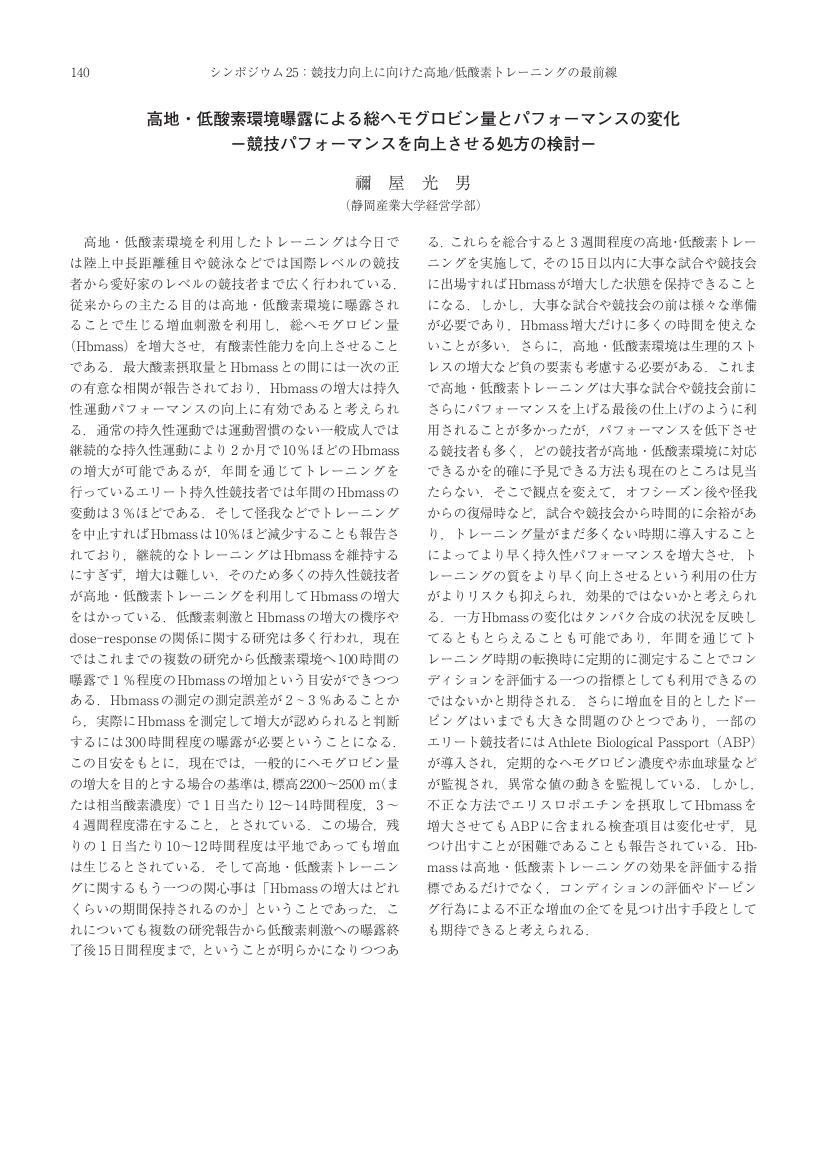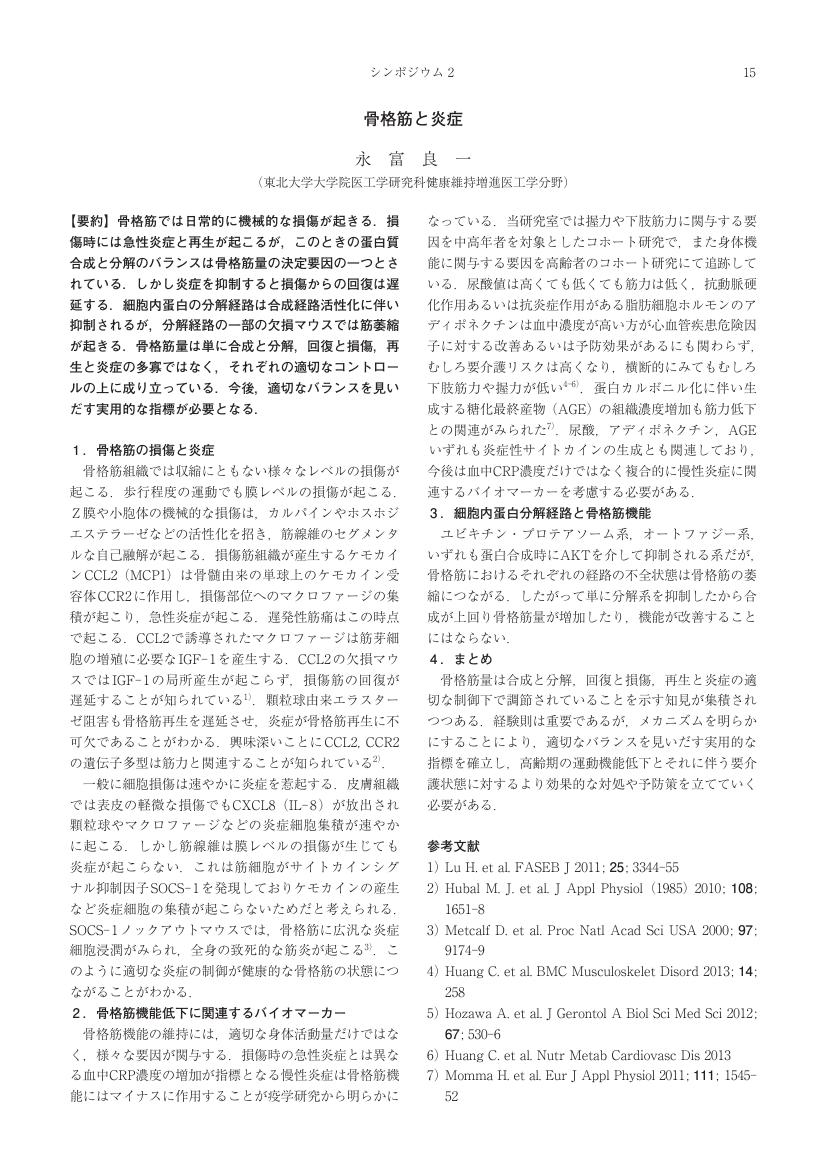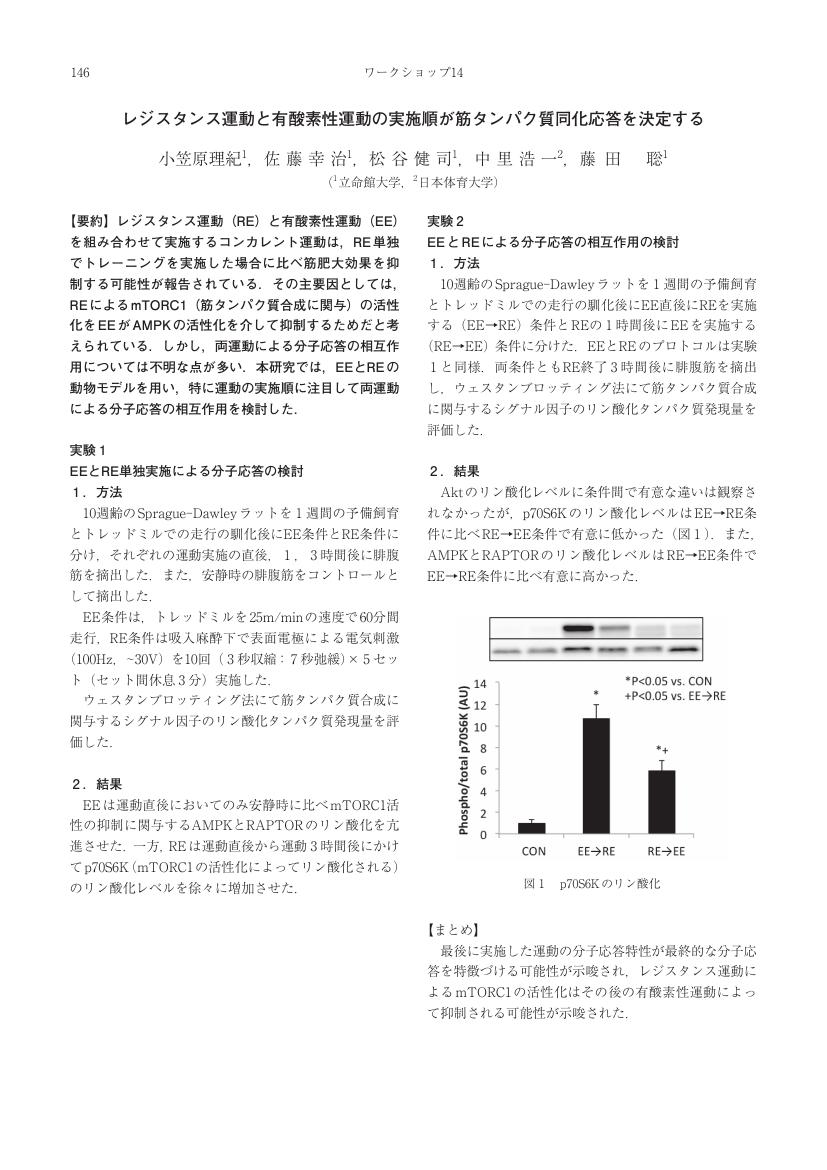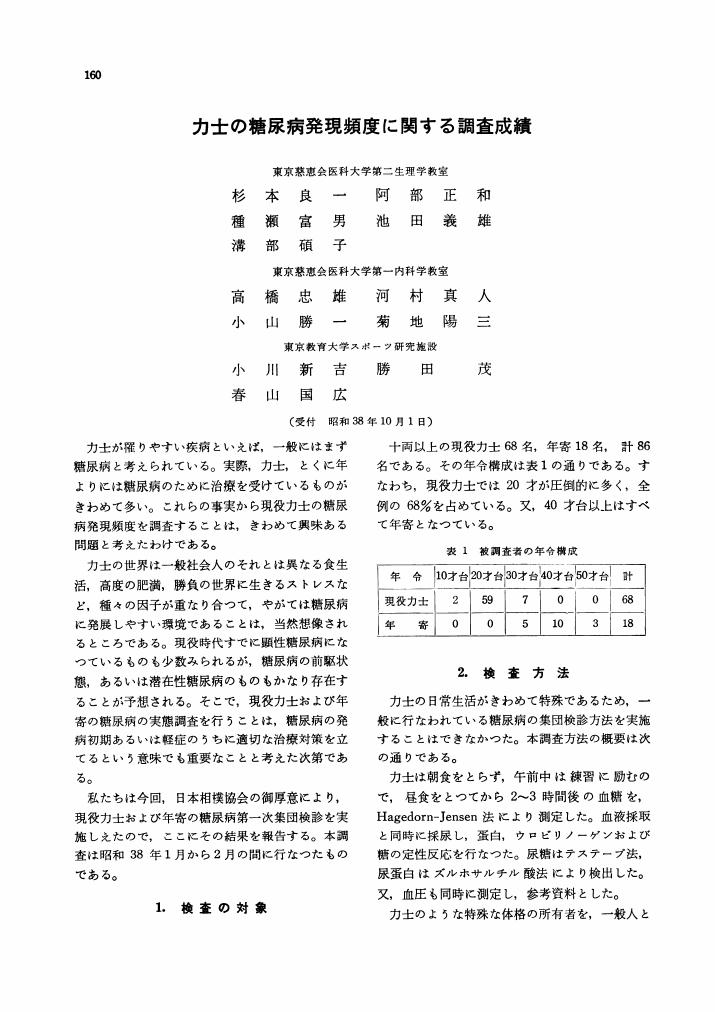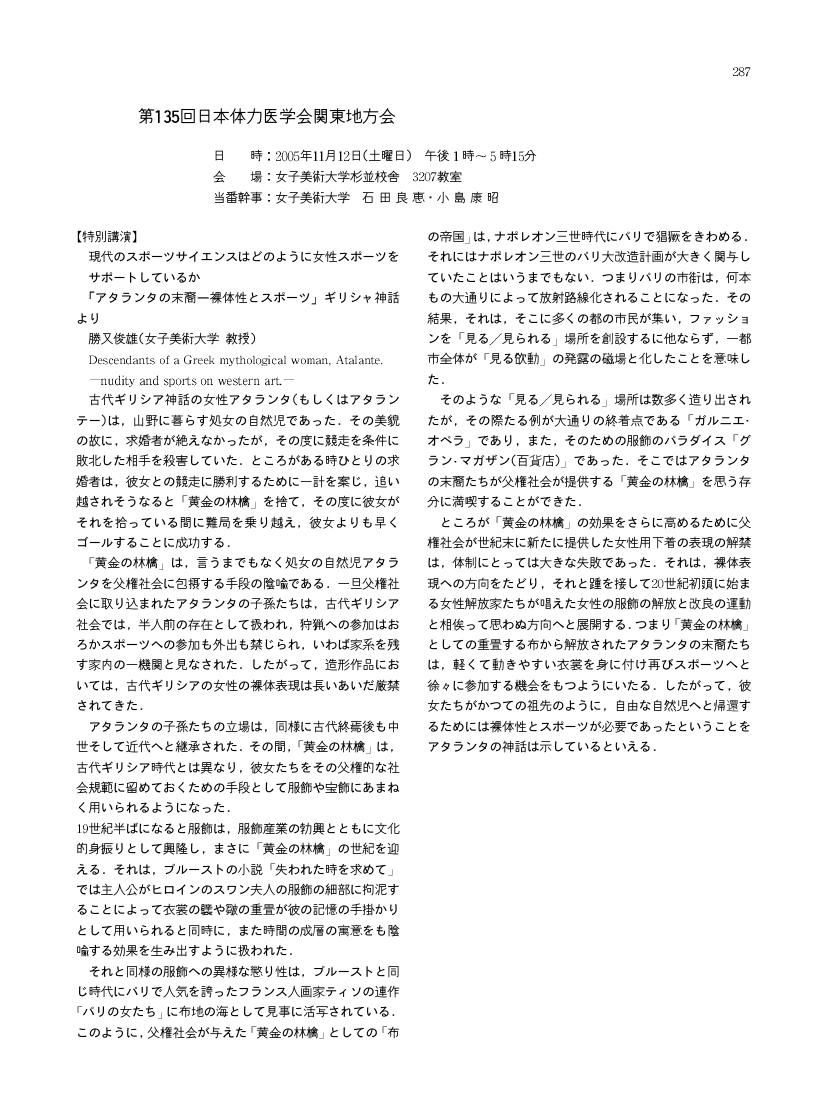- 著者
- 禰屋 光男
- 出版者
- 一般社団法人日本体力医学会
- 雑誌
- 体力科学 (ISSN:0039906X)
- 巻号頁・発行日
- vol.65, no.1, pp.140, 2016 (Released:2016-01-24)
172 0 0 0 OA 低糖質食事法およびレジスタンス運動が身体組成と血中代謝物・ホルモン濃度に与える影響
- 著者
- 伊藤 翔 唐沢 康暉 星野 太佑 藤井 雅史 衛藤 樹 鶴 純也 柏戸 千絵子 黒田 真也
- 出版者
- 一般社団法人日本体力医学会
- 雑誌
- 体力科学 (ISSN:0039906X)
- 巻号頁・発行日
- vol.68, no.3, pp.223-227, 2019-06-01 (Released:2019-05-18)
- 参考文献数
- 20
We clarify the effect of combination of low-carbohydrate diet and resistance exercise training on physical characteristics and plasma concentrations of metabolites and hormones in humans. Intervention of low-carbohydrate diet and resistance exercise training were performed on 7 healthy men and 3 women (age 39.6 ± 7.0 year; BMI 25.1 ± 3.6 kg/m2) for 8 - 12 weeks. Physical characteristics and 106 test items including and blood concentrations of metabolites and hormones were measured before and after the intervention. The effects of intervention were analyzed by a paired t-test, in which multiple testing was corrected by the method of Storey (significant variation q <0.1). In both men and women, carbohydrate and energy intake per day were low, and protein intake per day was almost the same as the recommended dietary allowance. Because carbohydrate intake were limited (174 kcal), resulting in reduction of total energy (1186 kcal). After the intervention, body weight, BMI (Body Mass Index), fat mass, body fat, muscle mass and body water content significantly decreased, while muscle mass per body mass significantly increased. Glycine, 3-methyl histidine, inorganic phosphorous, urea nitrogen, urea nitrogen per creatinine, were significantly increased, while HbA1c, white blood cell count, β-aminoisobutyric acid, adrenalin, free T4, blood ammonia, γGTP, cholinesterase, and leptin were decreased.
123 0 0 0 OA 骨格筋と炎症
- 著者
- 永富 良一
- 出版者
- 一般社団法人日本体力医学会
- 雑誌
- 体力科学 (ISSN:0039906X)
- 巻号頁・発行日
- vol.63, no.1, pp.15, 2014 (Released:2014-01-24)
- 参考文献数
- 7
72 0 0 0 OA ディトレーニング中のストレッチングが筋量に及ぼす影響
- 著者
- 笠原 政志 山本 利春 川原 貴
- 出版者
- 一般社団法人日本体力医学会
- 雑誌
- 体力科学 (ISSN:0039906X)
- 巻号頁・発行日
- vol.59, no.5, pp.541-548, 2010 (Released:2010-11-16)
- 参考文献数
- 47
- 被引用文献数
- 1
The present study was conducted to examine whether stretching was effective to control muscular atrophy.Subjects were eight male undergraduate students (height 171.4 ± 5.8 cm, body weight 72.2 ± 7.8 kg, and age 20.6 ± 1.1 years) and the muscle analyzed was the vastus lateralis.Firstly, the subjects were instructed to perform strength training for a period of 16 weeks, which was followed by a 12-week detraining period. During the detraining period, either the right or the left leg was stretched daily for 10 minutes (2 sets). The mass of the vastus lateralis muscle was estimated based on its cross-sectional area (CSA), as assessed by magnetic resonance imaging (MRI). Relative decreases in muscle mass were compared between the stretched and the non-stretched control leg.Muscle mass in the non-stretched leg showed significant decreases during detraining, while no significant decreases in muscle mass were detected in the stretched leg. This outcome indicates that stretching can influence muscle plasticity and, therefore, is effective for preventing decreases in muscle mass.In conclusion, this study suggests that, added to its known ability to improve flexibility, accelerate recovery from fatigue, and prevent injuries, static stretching is effective for controlling muscle atrophy.
55 0 0 0 OA 減量しながら筋肉量および基礎代謝量を高めることは可能か?
- 著者
- 田中 喜代次 中田 由夫
- 出版者
- 一般社団法人日本体力医学会
- 雑誌
- 体力科学 (ISSN:0039906X)
- 巻号頁・発行日
- vol.66, no.3, pp.209-212, 2017-06-01 (Released:2017-05-17)
- 参考文献数
- 7
- 被引用文献数
- 1
Most people who go to fitness clubs or sports gyms for weight control, and many co-medicals and physicians believe that an increase in muscle mass and/or basal metabolic rate (BMR) is possible through a combination of regular exercise and optimal protein intake during weight loss. This seems a myth, and the reasons are discussed in this article. First, muscle mass is quite difficult to quantify. The limitations of body composition measurement should be well understood. Second, increasing muscle mass during weight loss is difficult. This might be attained through strict implementation of a protein-rich, low-carbohydrate diet; high-intensity resistance training; and aerobic exercise for a long duration. However, such a strict regimen is not feasible for most people. Finally, a 1-kg increase in muscle mass corresponds to an increase of only 13 kcal of BMR per day. Thus, an increase in muscle mass of 1 kg is difficult to achieve, while the gained BMR is approximately equivalent to a decrease of 13.5 kcal of BMR according to a 3-kg decrease of adipose tissue. Weight loss, unless through an extremely sophisticated weight control program, contributes to a decrease in BMR. However, it is an accomplished fact that women with significantly less muscle mass and lower BMR live longer than men with more muscle mass and higher BMR, regardless of ethnicity. Maintaining activities of daily living and daily activity function might be more essential.
28 0 0 0 OA 睡眠不足による暑熱負担の増悪と予防対策
- 著者
- 時澤 健 田井 鉄男 呂 健 安田 彰典 岡 龍雄 高橋 正也 澤田 晋一
- 出版者
- 一般社団法人日本体力医学会
- 雑誌
- 体力科学 (ISSN:0039906X)
- 巻号頁・発行日
- vol.63, no.1, pp.96, 2014 (Released:2014-01-24)
23 0 0 0 OA 身体組成の評価方法間にみられる身体密度および体脂肪率の差の検討
- 著者
- 設楽 佳世 袴田 智子 大西 貴弘 池田 達昭
- 出版者
- 一般社団法人日本体力医学会
- 雑誌
- 体力科学 (ISSN:0039906X)
- 巻号頁・発行日
- vol.66, no.5, pp.369-382, 2017-10-01 (Released:2017-09-29)
- 参考文献数
- 41
- 被引用文献数
- 2
The objectives of this study were 1) to quantify the differences in body densities and percent body fat using various methods for evaluating body composition (e.g., underwater weighing (UWW), air displacement plethysmography (ADP), skinfold caliper (SKF) measurement, ultrasound (US), bioelectrical impedance analysis (BIA), and dual-energy x-ray absorptiometry (DXA)), and 2) to examine the relationship between trends of the differences in body density and percent body fat obtained by these methods and characteristics of morphology and body composition. To this end, the body compositions of 73 healthy male adults were measured using UWW, ADP, SKF, US, and BIA. Twenty-seven of these 73 subjects underwent further measurement using DXA. Differences in body densities determined with ADP, SKF, and US were compared with those measured using UWW as a reference, and the differences in percent body fat estimated with UWW, ADP, SKF, US and BIA were compared with those measured by DXA as a reference. The results of this study indicate that 1) ADP is useful as a method for evaluating body density, as the results differed insignificantly from the reference method and showed no systematic errors due to differences in morphological characteristics and body composition, and 2) UWW measurements exhibited the smallest difference in percent body fat from the reference method, however, more than in any other method, there were systematic errors due to differences in morphological characteristics and body composition, specifically, trunk composition.
23 0 0 0 OA 大腿四頭筋の廃用性筋萎縮を防止するために必要な下肢の運動量について
- 著者
- 市橋 則明 吉田 正樹
- 出版者
- The Japanese Society of Physical Fitness and Sports Medicine
- 雑誌
- 体力科学 (ISSN:0039906X)
- 巻号頁・発行日
- vol.42, no.5, pp.461-464, 1993-10-01 (Released:2010-09-30)
- 参考文献数
- 8
- 被引用文献数
- 7 4
A study was conducted to determine the minimum quantity of leg exercise required to prevent disuse atrophy of the quadriceps femoris muscle during bed rest. The subjects were 10 normal young university students with a mean age of 21.1 years. First, analysis of rectified filtered electromyography (RFEMG) was performed on the rectus femoris and vastus medialis during walking with cadences of 100 steps/min and 150 steps/min. Then, the effects of straight leg raising (SLR), patella setting (PS), knee extension-flexion in a supine position (KEF) and knee extension in a sitting position (KE) were analysed for each muscle using the same method. Based on the value of RFEMG for each muscle during walking, the repetition number for each exercise was calculated. For the rectus femoris, the repetition number for each exercise corresponding to 10000 steps with a cadence of 100 steps/min was 289 for SLR, 466 for PS, 1255 for LEF and 1663 for KE. For the vastus medialis, the corresponding numbers were 1223, 381, 6367 and 2170, respectively. When the cadence increased to 150 steps/min, the repetition number of each exercise for each muscle also increased. These results indicate that high repetition exercise is recommendable to prevent disuse atrophy of the quadriceps femoris muscle. Therefore, the activity of patients should be increased to stimulate weakened muscles such as the quadriceps femoris during hospitalization.
22 0 0 0 OA レジスタンス運動と有酸素性運動の実施順が筋タンパク質同化応答を決定する
- 著者
- 小笠原 理紀 佐藤 幸治 松谷 健司 中里 浩一 藤田 聡
- 出版者
- 一般社団法人日本体力医学会
- 雑誌
- 体力科学 (ISSN:0039906X)
- 巻号頁・発行日
- vol.63, no.1, pp.146-146, 2014 (Released:2014-01-24)
20 0 0 0 OA エビデンス:つくる・伝える・使う
- 著者
- 中山 健夫
- 出版者
- 一般社団法人日本体力医学会
- 雑誌
- 体力科学 (ISSN:0039906X)
- 巻号頁・発行日
- vol.59, no.3, pp.259-268, 2010 (Released:2010-07-15)
- 参考文献数
- 47
- 被引用文献数
- 5 1
EBM is the integration of best research evidence with clinical expertise and patient values. EBM has been extending to “evidence-based healthcare/practice” with wider perspectives. When considering healthcare-related evidence, it is useful to distinguish three aspects. Namely, they are “create”, “communicate”and “utilize”. At first, “clinical questions” are generated in real clinical settings. To create clinical evidence, “clinical questions” need to be refined as “research questions”. Concerning the aspect of communication, there are lots of proposals and statements to improve the reporting of research findings. The Uniform Requirements for Manuscripts Submitted to Biomedical Journals proposed by the International Committee of Medical Journal Editors has been evolved since 1979 and has become the global standard for scientific authors and editors. Concerning the aspect of “utilize”, there are two problems, that is, overuse and underuse of evidence. The former is related with the problem of evidence-practice gap. Appropriate use of clinical practice guidelines are expected to reduce these gaps. The latter is linked with the confusion that evidence equals EBM. Evidence is merely evidence even if the level is high in scientific and general meaning. When clinicians make individual decisions, they are required to do them comprehensively balancing the three factors such as evidence, value and resource.
20 0 0 0 OA 力士の糖尿病発現頻度に関する調査成績
19 0 0 0 OA 第135回日本体力医学会関東地方会
- 出版者
- 一般社団法人日本体力医学会
- 雑誌
- 体力科学 (ISSN:0039906X)
- 巻号頁・発行日
- vol.55, no.2, pp.287-293, 2006-04-01 (Released:2007-05-10)
19 0 0 0 OA 一過性低強度・低速度反復のレジスタンス運動が運動後過剰酸素消費 (EPOC) に及ぼす影響
- 著者
- 向本 敬洋 韓 一栄 大野 誠
- 出版者
- 一般社団法人日本体力医学会
- 雑誌
- 体力科学 (ISSN:0039906X)
- 巻号頁・発行日
- vol.57, no.3, pp.349-364, 2008-06-01 (Released:2008-08-13)
- 参考文献数
- 34
- 被引用文献数
- 1
The purpose of this study was to investigate the acute effects on excess post-exercise oxygen consumption (EPOC) of low intensity and slow-movement repetitive resistance exercise in moderately trained young men. Seven healthy trained young men (age=22±3 yr ; height=172.5±4.0 cm ; weight=69.5±8.3 kg ; VO2max=47.3±6.0 ml/kg/min) performed the following three exercise patterns on separate days : 1) high-intensity (80% one-repetition maximum : 1RM) and regular-movement repetitive exercise (1 second each of concentric and eccentric action, termed high and regular exercise (HRE) ; 2) low-intensity (50%1RM), regular-movement repetitive exercise (same movement speed as for HRE but termed low and regular exercise (LRE); and 3) low-intensity (50%1RM), slow-movement repetitive exercise (4 sec each of concentric and eccentric action, termed low and slow exercise (LSE). These three exercise patterns consisted of three sets of four exercises performed to maximum repetition. All subjects completed the three exercise sessions in a randomized and counterbalanced fashion. Oxygen consumption (VO2) and heart rate (HR) were continuously monitored during the exercise sessions and for 90 min afterwards. EPOC over 90 min was thus observed after completing the three exercise patterns. However, there were no significant differences in EPOC among the three exercise patterns. The results of this study suggest that low-intensity and slow-movement repetitive resistance exercise with maintaining muscular tension (LSE) is likely to increase EPOC to the same extent as HRE and LRE exercise patterns.
18 0 0 0 OA 野球投手の投球数の増加による下肢関節の力学的仕事量の変化
- 著者
- 平山 大作 藤井 範久 小池 関也 阿江 通良
- 出版者
- 一般社団法人日本体力医学会
- 雑誌
- 体力科学 (ISSN:0039906X)
- 巻号頁・発行日
- vol.59, no.2, pp.225-232, 2010 (Released:2010-05-27)
- 参考文献数
- 24
- 被引用文献数
- 2 3
The purpose of this study was to investigate the changes on mechanical work of the lower limb joints during baseball pitching in a simulated game. One male college baseball pitcher threw 15 pitches in an inning for 9 innings (135 pitches) in an indoor pitcher's mound with two force platforms. Rest time between innings was 6 minutes. Three-dimensional positions of 47 reflective markers attached to subject were tracked by an optical motion capture system (Vicon Motion System 612, Vicon Motion Systems) with eight cameras (250Hz). For subject 75 fastball pitches (1st, 3rd, 5th, 7th, and 9th innings) were chosen for analysis.As the main results, the hip joint extension absolute and negative work of the stride leg decreased with increasing the number of pitches. The ankle joint extension absolute and negative work of the stride leg increased with increasing the number of pitches. These results suggest that the hip joint extension torque of the stride leg was needed to maintain for higher performance in baseball pitching.
17 0 0 0 OA サウナ入浴法の検討
- 著者
- 水田 拓道 植屋 清見 日丸 哲也 永田 晟 山本 高司
- 出版者
- The Japanese Society of Physical Fitness and Sports Medicine
- 雑誌
- 体力科学 (ISSN:0039906X)
- 巻号頁・発行日
- vol.24, no.3, pp.101-107, 1975-09-01 (Released:2010-09-30)
- 参考文献数
- 8
目的に応じたサウナ入浴をするための一つの条件として, サウナ入浴時間が生体におよぼす影響というかたちで, 主に運動機能的な面からサウナ入浴前後, および入浴中の変化について比較検討した。本実験の結果からサウナの効果的利用法について次のような示唆が得られた。1.アンケート調査の結果, サウナ入浴時間においては5分単位の入浴を繰返している者が最とも多く60%余りをしめていた。また, 95%の者がなんらかの形で冷水浴を併用していた。2.全身反応時間, 膝蓋腱反射閾値, 垂直跳びにおけるジャンプパワー等, 筋神経系の関係する機能においては, 5分入浴, 1分冷水浴で3回繰返し入浴法が, 入浴前に比べてよい成績を示し効果的であることがわかった。このことから, 経験的に得た5分単位の入浴法が, 疲労回復, 気分転換等に効果的であることが裏付けられた。3.血圧, 心拍数, 皮膚温の変化には設定パターンによる著明な差異は認められなかった。しかし, いずれのパターンにおいても循環機能への有効な剌激として考察され, 長期にわたる利用によって環境温の変化に対する適応能を高める効果が期待される。4.サウナ入浴中の酸素摂取量は安静時に比して, パターン (1) が23.2%, パターン (2) が31.6%れぞれ増加した。エネルギー代謝促進の面からは少し長い入浴時間が必要と考えられる。
16 0 0 0 OA 摂取したエネルギーの体内での吸収と利用
- 著者
- 高田 和子
- 出版者
- 一般社団法人日本体力医学会
- 雑誌
- 体力科学 (ISSN:0039906X)
- 巻号頁・発行日
- vol.56, no.2, pp.287-290, 2007-04-01 (Released:2007-05-25)
- 参考文献数
- 5
- 被引用文献数
- 1
14 0 0 0 OA 細胞レベルでのストレス応答 ―ストレスタンパク質の発現と機能―
- 著者
- 内藤 久士
- 出版者
- 一般社団法人日本体力医学会
- 雑誌
- 体力科学 (ISSN:0039906X)
- 巻号頁・発行日
- vol.53, no.4, pp.455-460, 2004-08-01 (Released:2010-09-30)
- 参考文献数
- 37
- 著者
- 田中 千晶 岡田 真平 高倉 実 橋本 圭司 目澤 秀俊 安藤 大輔 田中 茂穂 Anthony D Okely
- 出版者
- 一般社団法人日本体力医学会
- 雑誌
- 体力科学 (ISSN:0039906X)
- 巻号頁・発行日
- vol.69, no.4, pp.327-333, 2020-08-01 (Released:2020-07-15)
- 参考文献数
- 24
- 被引用文献数
- 4
This study examined the relationship between meeting the World Health Organization’s (WHO) 24-Hour Movement Guidelines for the Early Years and motor skills and cognitive function in preschool children. Participants were 4-year-old boys and girls in urban and rural areas (n=69). Physical activity was measured using a triaxial accelerometer (ActiGraph GT3X). Screen time and sleep duration were assessed via self-report by guardians. Meeting the 24-h movement guidelines was defined as: 10 to 13 h/night and nap of sleep, ≤1 h/day of sedentary screen time, and at least 180 min/day more than 1.5 METs. Motor skills were evaluated by the Ages & Stages Questionnaires, Third Edition (ASQ-3). Executive functions (shifting, visual-spatial working memory and inhibition) were evaluated by the Early Years Toolbox (Japanese translation). The prevalence of children meeting all three recommendations was 7.2% and 7.2% met none of the three recommendations. Children meeting physical activity recommendation had a better inhibition score compared to children meeting none of the recommendation (p=0.005). While, children not meeting the sleep recommendation had a better inhibition score compared to children meeting of the recommendation (p=0.042). In conclusion, meeting the physical activity or sleep recommendations were positively or negatively associated with the inhibition score. On the other hand, meeting none of the sedentary behaviour and the 3 recommendations was not associated with motor skills or cognitive function.
13 0 0 0 OA ポケモンGOのプレイが日常歩数に及ぼす影響 −日本人男子大学生を対象とした後ろ向き観察研究−
- 著者
- 西脇 雅人 松本 直幸
- 出版者
- 一般社団法人日本体力医学会
- 雑誌
- 体力科学 (ISSN:0039906X)
- 巻号頁・発行日
- vol.67, no.3, pp.237-243, 2018-06-01 (Released:2018-05-16)
- 参考文献数
- 19
- 被引用文献数
- 1
This retrospective observational study aimed to examine the effects of playing Pokémon GO on daily steps of male college students. Twenty-five Japanese male college students (20 ± 1 years) were assigned to Control group (C, n = 11) or Pokémon GO group (P, n = 14) based on their playing Pokémon GO or not. Daily step levels were obtained from the health care app of Apple iPhone from September 2016 to October 2016. In P group, the data for the 4 weeks to determine baseline values and for the 4 weeks of playing Pokémon GO were analyzed. The steps data of C group were also analyzed in the same period of the total 8 weeks. There were no significant differences in steps at baseline level between both groups. In addition, no significant time-course changes in steps were observed in C group. In contrast, steps in P group significantly increased from baseline 8,368 ± 544 steps/day to week 1 10,028 ± 617 steps/day (P < 0.01). The changes in steps from baseline to week 1 were significantly greater in P group than in C group (1,671 ± 345 vs. -81 ± 582, P < 0.01). However, the increased steps returned to baseline level by week 2, and the values did not increase again. Therefore, our findings indicate that playing Pokémon GO increases daily steps only during one week in Japanese male college students.
12 0 0 0 OA 投球動作の肩最大外旋角度に対する肩甲上腕関節と肩甲胸郭関節および胸椎の貢献度
- 著者
- 宮下 浩二 小林 寛和 越田 専太郎 浦辺 幸夫
- 出版者
- 一般社団法人日本体力医学会
- 雑誌
- 体力科学 (ISSN:0039906X)
- 巻号頁・発行日
- vol.58, no.3, pp.379-386, 2009-06-01 (Released:2009-07-28)
- 参考文献数
- 31
- 被引用文献数
- 3 2
The purpose of this study was to identify the angles of the shoulder complex which consist of glenohumeral joint, scapulothracic joint, and thoracic joint at the maximum external rotation (MER) of the shoulder complex during throwing in baseball players, and to analyze the correlation of each angle.The subjects were 19 collegiate baseball players. Throwing motion data was collected by three high-speed cameras and the three-dimensional (3D) coordinates of the shoulder complex were established by direct leaner translation method for the MER calculation. A 3D analysis was performed to obtain the external rotation (ER) angle of the glenohumeral joint, the posterior tilt angle of the scapula, and the extension angles of thoracic at MER of shoulder complex. The mean (±SD) value of the MER was 145.5±10.3°. The mean (±SD) values of the glenohumeral ER, the scapula posterior tilt angle and the thoracic extension angle at MER were 105.3±16.0°, 24.3±15.0°, and 9.1±7.2°respectively. Multiple linear regression analysis was used to relate the MER angle to each joint angle. The final linear regression model included the posterior tilting angle of scapula ( r=0.56, p<0.05), and external rotation of the glenohumeral joint ( r=0.40, p<0.05). Significant negative correlation was observed between the posterior tilting angle of the scapula and external rotation of the glenohumeral joint ( r=-0.52, p<0.05). This finding suggested that scapula motion could be very important for the prevention of throwing injuries.
